Brief History of Alexandria 1800 - 2008 - Page 1
Page 2 | Page 3 | Page 4 | Page 5
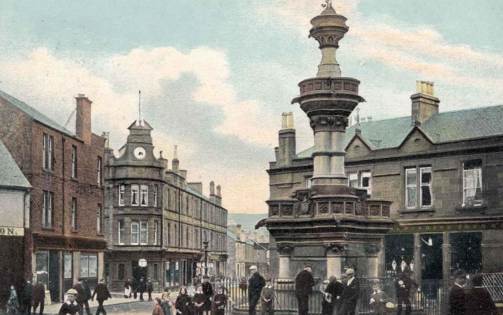
Alexandria is the largest town in the Vale of Leven, with a population of over 10,000, which is a bit ironic since it was the last town or village in the Vale to put in an appearance. Until the 1780's it was at most a road junction where stood an old oak tree and a grocers shop and house. At the road junction, the road which ran down the west side of Loch Lomond to Dumbarton Bridge was met by a short road running south-eastward to the River Leven crossing, which was initially a ford and then in the late 18th century a ferry and from 1836 a bridge. This junction was almost exactly where the Fountain now stands.
The Old Oak Tree was located about 6 or 7 yards north of this. 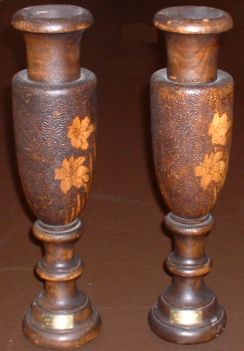 It slowly died over a few years
and had to be cut down, which it was on 3rd October 1865. The vases pictured were made from the wood from the old oak tree. They belong to the Vale of Leven Bowling club. Five years later, the Fountain, a memorial to Alexander Smollett MP for Dumbarton from 1841-59 and a “kind and just landlord” was unveiled.
It slowly died over a few years
and had to be cut down, which it was on 3rd October 1865. The vases pictured were made from the wood from the old oak tree. They belong to the Vale of Leven Bowling club. Five years later, the Fountain, a memorial to Alexander Smollett MP for Dumbarton from 1841-59 and a “kind and just landlord” was unveiled.
The road running down from Loch Lomondside is now called Main Street, while the road down to the Ferry is now called Bank Street. It was originally called Ferry Loan, appropriately enough, and indeed that name survives in another road which runs off Bank Street between the railway line and St Mary's school, and which was for many years the entrance to Our Lady and St Mark's church.
The grocer's shop at the old oak tree, served the whole area on the west side of the Leven and probably southern Loch Lomondside as well, the whole area being pretty sparsely populated at that time. Until about 25 years ago it was universally accepted that the original name for Alexandria was “The Grocery”. However, in their book “On Leven's Banks” (1980), Arthur Jones & Graham Hopner show that the growing clachan was on record as being called Alexandria from 1788, named after Alexander Smollett.
This Alexander Smollett then got himself killed in 1799 at the battle of Alkmaar in the Netherlands. The first recorded reference to The Grocery, on the other hand, was not until 1797, and even then it seems to have been made by the grocer himself, who not unreasonably, described himself as living in “The Grocery”. Jones & Hopner suggest that it is likely that the locality around what is now the fountain was known as The Grocery, but was part of the larger area already known by that time as Alexandria. That seems very likely to have been the case. The Smolletts owned most of the land on the west side of the Leven, and a good deal on the east side as well, and they could call anywhere they owned anything they wanted.
Mrs Jane Telfer Smollett had already decided in 1762 to call her model village Renton after her daughter-in-law. With the growing housing needs of the people who were already beginning to arrive to work in the factories at Dalquhurn and Cordale in Renton and Ferryfield, Levenfield and Croftengea in Alexandria, it was obvious that a great deal of housing would be required. That naturally suited Smollett who owned a great deal of land which was very suitable for house-building. What was more natural than earmarking an area for a new village or town and giving it a name of your choice? This is exactly what modern developers and house-builders do in the Vale today.
The Single ownership of the land and the topography of the area were the main reasons why Alexandria became the largest town in the valley. The west side of the valley is flatter than the east. By the time it gets to Alexandria the valley is broader too. There was much more land to build on easily in Alexandria than in Renton - although the Renton factories employed more people to begin with. Similarly with Bonhill, where the hillside rises quickly from a narrow plateau.
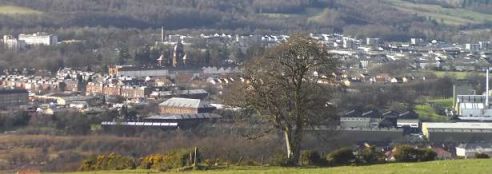
The Vale of Leven from the Bonhill side behind the Golf Course. The old building
in the
foreground to the left of the tree is part of the Croftengea works, "The Craft".
In 1800, however, Alexandria consisted of little more than the two roads which have been mentioned, the grocery with a few houses around it, and a farm steading just south of it. A road, or more likely a track, ran down from Main Street to the Levenfield and Croftengea works around which clustered some houses, including two-storey houses for workers. 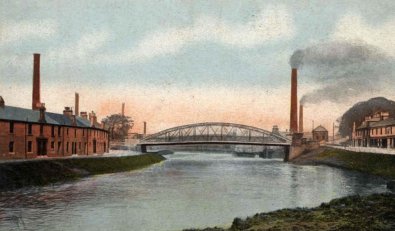 Ferryfield works which were accessed from Ferry Loan.
Ferryfield works which were accessed from Ferry Loan.
At the bottom of Ferry Loan stood Ferry House at the Ferry crossing about 10 yards from the river - perhaps on the site of the building where the dentists now is at Bonhill Bridge (old bridge pictured). The Ferry House served a number of functions. It was first and foremost where the ferryman lived; it also served as a pub as a side line, and it was from the door of the Ferry House that the coach departed for the Dumbarton steamers complete, with the red-coated driver, and a boy-guard blowing his horn. Also down Ferry Loan, towards the ferry, already stood the two-storey building which later in the century got the name “Wee Hell” because of the anti-social nature of its tenants. It probably deserved the name, certainly if the behaviour of one of its tenants is anything to go by. Pat Lunnay committed a pretty gruesome murder in the building, for which he was hanged in Dumbarton Gaol in 1861, the last person to be executed there. (See right column.)
The factories were not the large brick-built buildings with which we are now familiar - they started to appear in mid 19th century when existing factories were altered or extended - but rather smaller stone-built structures. We know from Dorothy Wordsworth's account, that there were a number of workers tenements already in place in Renton and Alexandria in 1803.
The largest house in Alexandria was the Place of Bonhill which the Smolletts of Bonhill had vacated in 1762 when they moved to Cameron House on Loch Lomondside, and into which the Turnbull family moved in 1806 after they had extensively restored the building– hence Turnbull's (or Trumull's) Loan. At this time, the boundary between Renton and Alexandria was already in place because it was the parish boundary between Bonhill and Cardross parishes - Alexandria being in Bonhill parish while Renton was in Cardross parish and the Millburn Burn was the boundary on the floor of the valley, with Turnbull's Loan being the first / last road in Alexandria.
The Millburn Burn rose in the Poachy Glen on Carman Hill and flowed down to a dam which drove a 22 foot diameter mill wheel of a grain mill in Millburn quarry. This was owned by the Turnbulls who knocked it down in the 1790's and replaced it with the Millburn Pyroligneous and Liquour works to make dye-stuffs for the textile factories.
We don't have separate population figures for Alexandria in the early 1800's but we know that the Bonhill parish population in 1801 was 2,460, of which probably about 1,000 people lived in Alexandria. This suggests about 200 separate houses in Alexandria and if you assume about 30 of these were farming-related, there would have been about 170 workers' houses in a mixture of tenements and single-occupancy cottages, and this probably amounted to no more than 30 separate buildings mostly close to the factories.
In 1801 there wasn't one completed side street running down to the river from the centre of Alexandria. The only approach was the Charleston Row, or Red Row as it was known which was near the entrance to the Croftingea and Charleston works. There were a small number of houses in Smiddy Street, which became Susannah Street. At the top of the Street, close to what was then still Ferry Loan, was the blacksmith's shop, after which the street was named. Further up Smiddy Street was Alexandria's first purpose built pub - Black Bull Inn.
Attached to the Inn was a hall in which social functions such as weddings
took place. Across from the Black Bull and on the corner of Ferry Loan, was
a strangely-shaped building which was called the Devil's Elbow. This survived until the 1890's when it 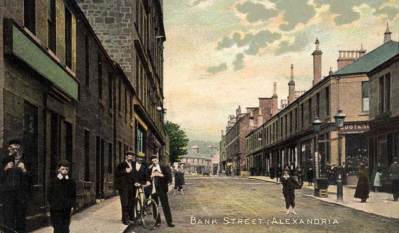 was
knocked down and Weir's Building was built in its place on what was by that time the corner of Susannah Street and Bank Street.
was
knocked down and Weir's Building was built in its place on what was by that time the corner of Susannah Street and Bank Street.
Further down Smiddy Street was an industrial building - Gardner's Foundry which no doubt was a supplier to the local works. It remained on that site until about 1886, by which time it which had changed hands, been renamed the Lennox Foundry and moved to the site that that building presently occupies in the aptly named Lennox Street. Vale of Leven Football Club's North Street Park, which they occupied until 1888, was adjacent to the new foundry location.
In the triangle formed by the Ferry Loan / Main Street junction was a farm steading with grass parks behind it extending south towards Renton. Early in the 19th century a number of small houses were built on the steading land, and these small houses were later (probably about 1850-60) replaced by two-story buildings, a number of which still stand to-day between the Fountain and the Bank of Scotland building in Main Street.
In the 1820's and 1830's, streets were being laid out and houses being built to form the inner core of Alexandria which remained essentially the same until the drastic and changes brought about by town centre development in the 1970's. A very few of these houses from 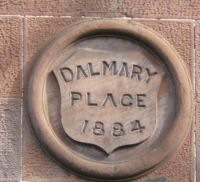 the
1800 - 1820's still exist - e.g. Rowan Tree Bank on the west side of Main Street just south of Upper Bridge Street. Typically, these houses are lower than the late Victorian houses with which they co-exist to-day. Some were thatched and all were generally smaller, probably the majority of the early houses were single story, of stone, rather than brick construction.
the
1800 - 1820's still exist - e.g. Rowan Tree Bank on the west side of Main Street just south of Upper Bridge Street. Typically, these houses are lower than the late Victorian houses with which they co-exist to-day. Some were thatched and all were generally smaller, probably the majority of the early houses were single story, of stone, rather than brick construction.
The streets which were started at this time included Mitchell Street, Random Street, and Ann Street (later renamed Church Street) to the south of the Old Oak Tree and Croft and North Streets to the north. Also, house-building on Main Street and Ferry Loan now began. The scale of this growth is evidenced by the move, due to popular demand, of the Bonhill Parish school on the west side of the Leven, from the Smollett's Cameron estate to  a site in Croft Street, where it was in the heart of a fast-growing child population.
a site in Croft Street, where it was in the heart of a fast-growing child population.
Within a few years these premises proved too small, and funds were raised in 1828 to build a larger school. This was in Susannah Street, and probably in 1829 that school opened (an interesting reflection on the times is that the old school in Croft Street was then converted to the village poorhouse). However such was the pace of growth of Alexandria, that within twenty years Susannah Street School itself proved to be too small, and Main Street School was opened about 1850, the pupils transferring to it.
The Susannah Street Schoolroom building passed into the hands of the community and was used for mainly social functions. It survived until the1970's redevelopment.
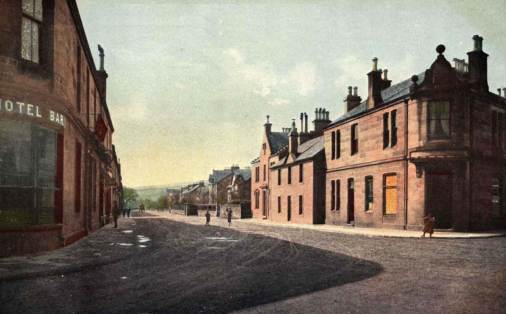
Main Street Alexandria Early 1900's?
Over the next 20-30 years substantial changes took place as the population continued its steady climb. By 1841 we have the first separate population figures for Alexandria - 3,039 - and there were big increases in the other Vale villages during this period as well. For the first time we know where people were staying, because the 1841 census divided Alexandria into 5 areas as follows:
1. Main Street from South to North |
954 people |
2. Ferry Loan, Bonhill Crescent, Millburn |
857 people |
3. Susannah St, Mitchel St, Bishop St, Water St |
637 people |
4. John St, Gas St, Charleston |
636 people |
5. Landward part North of Alexandria village |
300 people |
The spellings are as they appear on the census report. We see that by 1841, Main Street had filled out into a fairly populous place, and the streets on both sides of Ferry Loan were substantially populated. By now, North Street, Croft Street, Susannah Steet, Steven Street, Mitchell Street, Random Street, Ann Street, Bridge Street and the Crescent all had houses on them as well as the houses at the Craft gate which we would later know as India Street. John Street was probably impacted by the arrival of the railway. Also, there are street names on the census which did not last into the later part of the 19th century such as Water Street and Bishop Street - where were they?
This population growth of the early 1800's resulted from the growth in economic activity in the Vale, and it was accompanied not just by house building but by the creation of a substantial infrastructure - social and physical - and by a succession of imposing public buildings. All of these processes accelerated throughout the rest of the century. Although there were economic downturns in the factories in the 1830's 1850's and 1870's the Victorian age was a period of great success and growth for the Vale.
 In 1834 a gas supply became available in the area, although to begin with this was on a very small scale. It was not until the 1880's
that gas came into general use. By then the gasworks were in place in North
Street and had to be expanded a number of times to meet the growing demand
of the expanding community. This included building the gas holder which lay
at the foot of Wilson Street and North Street until the 1960's, partly on the site of the Vale of Leven Football Club's second ground - North Street Park, which the Vale vacated when they moved to Millburn in 1888.
In 1834 a gas supply became available in the area, although to begin with this was on a very small scale. It was not until the 1880's
that gas came into general use. By then the gasworks were in place in North
Street and had to be expanded a number of times to meet the growing demand
of the expanding community. This included building the gas holder which lay
at the foot of Wilson Street and North Street until the 1960's, partly on the site of the Vale of Leven Football Club's second ground - North Street Park, which the Vale vacated when they moved to Millburn in 1888.
The gasworks went out of operation when in the 1950's a huge new gasworks was built in Dumbarton (this was swiftly made redundant by the discovery and distribution of North Sea gas in the 1970's).
Around 1834 the Vale of Leven Mechanics Institute for adult education was founded. It was originally based in Dalmonach School (attached to Dalmonach Works, and as a B-listed building, still standing at the time of writing) until the opening of the Public Hall in Alexandria when it and its library of about 1,500 books transferred there. Also on a bookish theme, a Vale of Leven Literary Association with 40 members was formed in the 1850's.
Page 2 | Page 3 | Page 4 | Page 5


